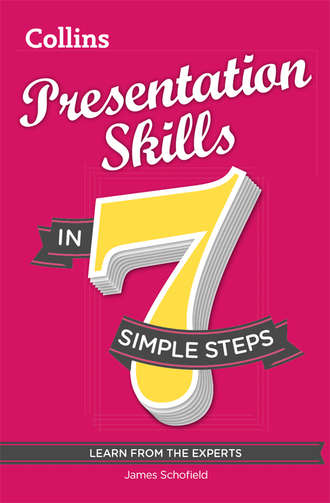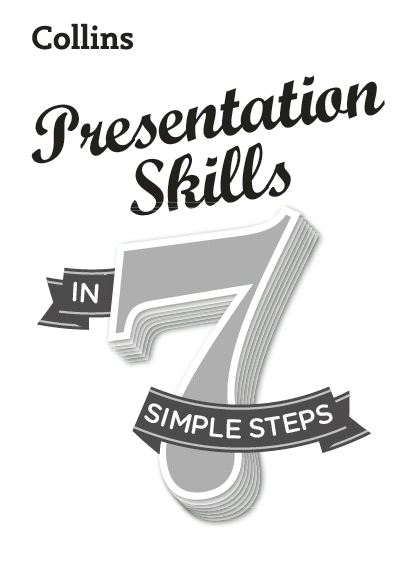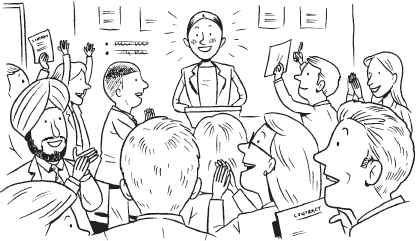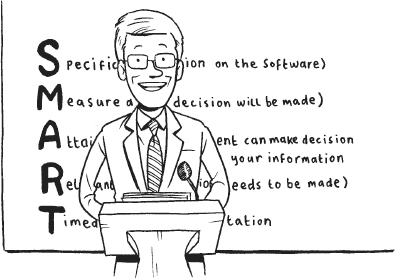
Полная версия
Presentation Skills in 7 simple steps


Contents
Step 1 Prepare for anything and everything
Step 2 Choose your tools and structure
Step 3 Assess the venue and equipment
Step 4 Make an impact
Step 5 Use the right body language
Step 6 Deal with nerves
Step 7 Turn questions to your advantage
Keep Reading
About the Author
Copyright
About the Publisher
Step 1
PREPARE FOR ANYTHING AND EVERYTHING
‘The person who uses a lot of big words is nottrying to inform you; he’s trying to impress you.’ — Oskar von Miller, engineer (1855–1934)
Five ways to succeed
Start small – contribute actively in meetings.
Look for opportunities to give presentations.
Get tips in advance from experienced presenters.
Take risks – try out different approaches to presentations.
Ask for feedback and learn from your mistakes.
Five ways to fail
Avoid presentation opportunities.
Leave preparations to the last minute.
Prepare everything alone.
Be overconfident.
Assume your audience shares your opinion.

So, a couple of weeks ago your boss asked you to give a presentation but now, as the deadline gets closer, you’re having doubts. What made you say yes? The first thing to realise is that you’re not alone, and this book is about the difference between those for whom presentations will always be a form of medieval torture and those who learn to enjoy them. Because learning how to present is a really good idea.
Profile
There are many ways to get yourself noticed at work. Some, like singing My Way on a karaoke machine at the office party, won’t help your career. Others, like being good at your job, probably will. But combining being good at your job with the ability to stand in front of a bunch of strangers or your colleagues and tell them about it will get you to the top.
Transferable life skills
Presentation skills have a wide application. You’ll be able to talk with confidence and assurance to complete strangers. You’ll be able to get people to listen to you and you’ll be able to use your voice and body language to influence people. These skills are useful at work and outside it as well. Think about the possibilities.
Knowledge sharing
This is the information age. But it can be difficult to sort out the relevant information from what is irrelevant. When you give a presentation, you’ll find that you attract people to you who can add information to what you know already and make it better. It’s a simple calculation: talk to one colleague about what you’re doing and you’ll get one person’s input, which may or may not be useful. Talk to fifty and the chances are much higher that you’ll learn something new that you can use.
Networking
Presenting will give you great opportunities to network with a lot of like-minded people at the same time. Who knows, one of them might be the person who gives you your dream job at some time in the future.


Before you start work on your presentation, it’s smart to do some research. The more you find out about what’s required in advance, the better the end result.
Presentation types
The first thing you need to find out is what kind of presentation is required. There are several types, each with its own distinct purpose and challenges.
1 Information sharing
This is the most frequent type of presentation. It’s used for bringing a group of people up to speed about a topic of mutual relevance, for example sharing information about the status of a project or changes in the organisation. Sometimes you might be asked to present regularly at a monthly meeting. It’s important for information-sharing presentations to sound neutral because people need to be allowed to draw their own conclusions about what you tell them. If you don’t sound neutral, then you run the risk that your audience will reject what you say because they believe you to be biased. So the challenge lies in sounding neutral without being dull. You can do this by making clear to people how something affects them directly: As soon as the system is ready, we need to be able to use it efficiently.
2 Training
Although a lot of companies now use fewer classroom training sessions, there are still many situations where they are the best way to share knowledge quickly. If you are the expert for a particular system, process or tool, you may be asked to train other users even if you don’t have a background in training.
The difficulty is to judge how quickly your audience will get the key points. What might seem dead easy to you could be baffling to them. On the other hand, if you make things too easy, you run the risk of your audience feeling patronised. A good approach is to collect feedback as you go. This could take the form of asking ‘test’ questions after each central point: So, those are the advantages I see with the new software. How do you feel about them? This helps you to gauge if you’re getting the content level right for your audience.
3 Selling
For some people ‘selling’ is still a dirty word. It smacks of pushy door-to-door sales people or TV shopping channels. But actually, we all need to sell things, even if it’s our own skills, when we go for a job interview.
The key to being good at sales is to think how your product or service will make the life of the listener better: Using this database is going to make your research much more accurate. If you approach sales with this attitude, you can feel comfortable with what you are doing.
4 Introducing change
It’s a fact that most people don’t like change. We’re all creatures of habit so when we first hear about something new, we tend to reject it as unnecessary. There is often an element of fear in this response. A change can have an impact on people’s own interests, aspects of their jobs and even their personality, and as a result, an audience may have very negative reactions to the presenter. Everyone who tries to introduce change experiences this, from a top CEO trying to restructure her entire company down to a team assistant who wants to convince his office colleagues that a new rota system for making coffee in the morning is mission critical.
What can you do to combat this? The best way is to get the people affected involved in discussion. Simply informing them of a change is likely to lead to resistance, either active (Who do you think you are? I’m not doing that!) or passive (I’ll get round to doing that – sometime). So outline to the audience what the current situation is, give clear reasons why change is necessary, outline possible solutions, and then engage the audience in discussion about the merits or demerits of these solutions. Let the audience see that you are interested in their opinions and want to involve them in finding the best solution. That way you’ll get them on board and willing to cooperate.
Clarifying objectives
Once you’ve worked out what kind of presentation is needed, you can move on to thinking about what you need to achieve. To do this, you need to answer four key questions.
How much time have you got?
What practical details should you check about the audience?
What influence does their part of the company have on them?
What is your goal in the time available?
1 How much time have you got?
This is a question that needs to be clarified with the presentation organisers before you start detailed preparation. It’s important because if you don’t know how much time you have, it’s easy to produce too much material for the time you have available. There are several possible consequences.
You’re asked to stop before you get to the conclusion.
You rush through your material and lose your audience because they can’t keep up with you.
You don’t have enough time to deal with questions from your audience.
It’s hard to define how much time you should allow for questions and discussions because it depends on how controversial the topic is and the type of presentation you’re giving. But in general, it’s advisable to plan for at least twenty-five per cent of your time slot to be given over to dealing with questions.
2 What practical details should you check about the audience?
Your audience should always be in the foreground of your preparation. Ask yourself these questions.
How many people will be there? The number will have an impact on what technology you use and how you talk to them. If it’s only a small number, you can ask them direct questions or get them to discuss something. With a larger audience, you might need a microphone and speakers.
What do they know about my topic already? Don’t overestimate their knowledge or underestimate their intelligence. If it’s a complex topic, use a simple analogy that they can relate to. For example, you could compare an electrical circuit with traffic flow controlled by traffic lights. If you’re giving an internal presentation, think about what your colleagues already know and what will be new to them.
How do they feel about my topic? The reaction of your audience can normally be predicted. Be ready for this by preparing concrete evidence to confirm what you’re saying.
What can they do with the information they get from me? Ideally, you should give your audience something they can take away and use themselves. On the other hand, in a regular internal meeting you may need to get information from some of your colleagues. Make sure you get it.
Take this pro-active approach to your presentation and it will come through in the way that you talk about your subject. If you treat an audience as you would a friend, they’ll return the favour.
3 What influence does their part of the company have on them?
Finding out where your audience comes from can be enormously important because you might need to adapt your message or style depending on their background. Supposing you had to present a recommendation to introduce new accounting software to different groups within a company, how might you need to change the focus of your talk? What things should you take into account?
Management will want to hear about the cost savings that it will generate. The technical side will likely be unimportant to them except for any risks caused by technical problems.
IT will want to be reassured by your description of its development that it fits into what they already have. They will be concerned about any difficulties that the new software may cause their servers.
Accounting staff will want to know if the software will make their work more accurate.
Sales people will expect you to sell something to them so they will be less interested in the development of the product and more interested in how it will make their lives easier.
This is just the beginning; you might need to present the topic to people who have just joined the company or students from a local business college. And of course, you might well have representatives from all these different groups in your audience. The point is, the more you know about their interests, the better able you are to tailor the presentation to them.
4 What’s your goal?
There’s an old saying: If you don’t know where you’re going, you’ll never get there. It’s essential to have a clear idea of what you want and what’s possible in the time available. Better to aim low and hit your target than be too ambitious and miss completely; so write down a sentence defining your goal: After my presentation, management can make a decision about whether or not to implement the proposed software.
Now test your goal to see whether it’s realistic by applying the SMART (Specific, Measurable, Attainable, Relevant, Timed) criteria to it. In the example above, the goal is:
Specific (decision on the software)
Measurable (a decision will be made)
Attainable (management can make the decision based on your information)
Relevant (a decision needs to be made)
Timed (after your presentation).


Once you’ve sorted out the parameters for your presentation, it’s time to look around for people or tools that can help you to get ready. Since you’re reading this book, you’ve already taken the first step in that direction – congratulations! But there are other things you can do to stack the odds in your favour.
Finding a mentor
Most people are willing to share their experience with less experienced presenters. Look for somebody who could act as a presentation mentor. It could be somebody you’ve seen giving a good presentation or it could be a co-worker whom you trust. Ask them to observe you doing a dry run of your presentation and to give you feedback. If possible, film it and watch it yourself to learn what can be improved.
Learning from the internet
The internet is full of information on every aspect of presentations, whether it’s the creation of visual aids or people giving live presentations. Some of these can be confusing rather than helpful but the TED Talks (www.ted.com) are a good source of excellent presentations to watch. These short talks (3–20 minutes) are entertaining, interesting and some of the best real-life models of what you want to achieve.

Once you have these supporting elements in place, you can start getting together the material you need for your presentation. What should you be aware of?
Staying relevant
It sounds obvious but the most important thing to remember about your choice of material is that it must be relevant. All of it. There’s always a temptation to include an unnecessary story or visual aid because it’s entertaining or interesting. Shoot these puppies right at the start of your preparation because if you allow them into your presentation, you will quickly get fond of them and they’ll be much harder to get rid of later when you realise you have a time problem. Everything you include must underpin the presentation goal that you set yourself before you get to this stage.
Quality
Again, this may sound obvious but are you sure that the information you’re presenting is correct? Have you considered points of view other than your own? Do your conclusions make sense? If you’re presenting a topic to a group of experts from your own field, you can guarantee that they’ll spot any inaccuracies in your claims. Make sure you can justify anything that you say.
Quantity
There is an important reason why you need to be careful about quantity – your audience’s capacity to absorb what you have to say. We find it hard to remember the content of a presentation if there are too many distinct points in it. This means that ideally you should limit what you say to three main points. This isn’t always possible, but it’s very hard for your audience to process and retain more than four points.
So what do you do if you look at the material you’ve collected and you feel that your presentation needs more than just three points to get the desired concept across? You have to cluster your information into three to four key headings. Look at this example.
Subject: New software
Key points: faster processing of information, handles larger quantities of data, support from external consultants necessary, high costs of new licences, hardware update necessary to handle new software, staff training necessary for new software, complex company-wide rollout, better data security
These eight key points can be clustered under three distinct headings. For example:
New software advantages: faster processing of information, handles larger quantities of data, better data security
New software disadvantages: high costs of new licences, staff training necessary for new software, complex company-wide rollout
Recommendation: support from external consultants necessary, hardware update necessary
Your audience will remember the three headings from your presentation and if they want the details, they can check the handouts or a copy of the presentation that you can make available for them.
Processing your material
Once you’ve collected your material and clustered it under three main headings, you need to reduce each point under those headings into the essential information that you must be got across. For each point, create ‘must know’ statements and then turn each statement into key words. These key words will be very helpful later when you’re creating your presentation notes and your visual aids so it’s worth investing the time. Here are some examples.
New software advantages
Must know: The data can be handled much faster by the new software. Key words: Faster data processing Must know: The new software will increase the degree of data security. Key words: Data security increasedNew software disadvantages
Must know: Staff will need to be trained on the new system. Key words: Staff training necessary Must know: The new software licences are expensive. Key words: Cost of new licencesRecommendation
Must know: For the complex company-wide rollout, we’ll need external consultants. Key words: External consultants for rolloutThis processing of your material is just as necessary for diagrams and charts. Always look at them with a critical eye and ask yourself how you can cut, reduce and simplify them so that the point you’re trying to make is as clear as possible.

Later on we’re going to look in detail at how to give your presentation real impact, but it’s worth considering what can make you a stylish presenter from the very start.
Being clear
If you talk to your audience in language that they can relate to, then you’re treating them with a respect that they will return. But giving a presentation can sometimes bring about alarming changes in a speaker. Firstly, there are speakers who litter their presentation with obscure acronyms such as SOD (separation of duties) or SOX (Sarbanes Oxley Act) that are common in their field but not known outside it. Secondly, there are speakers who have the mistaken belief that they need to use a particular style of business jargon in order to be taken seriously by their audience. Presenters no longer look for ways to work together, they look for ‘synergies’. They don’t encourage staff, they ‘incentivise’ them. They don’t have detailed plans, they have plans with a ‘high degree of granularity’.




